|
|
Etymology | History |
Tribes and Clans | Demography |
City | Topography |
River Jhelum |
Agriculture | Flora and Fauna |
Important Sites |
Transportation | Journalism in Jhelum
| Education | Hospitals |
Major Industries |
Notable People |
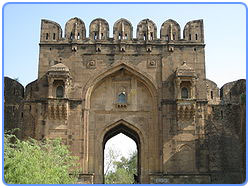 Jhelum District is in the Punjab province of Pakistan. According the 1998
census the district had a population of 936,957, of which 31.48% were urban.
The district of Jhelum stretches from the river Jhelum almost to the Indus.
Salt is quarried at the Mayo mine in the Salt Range. There are two
coal-mines, the only ones worked in the province, from which the
North-Western railway obtains part of its supply of coal. The chief centre
of the salt trade is Pind Dadan Khan. Jhelum is known for providing a large
number of soldiers to the British and later to the Pakistan armed forces due
to which it is also known as city of soldiers or land of martyrs and
warriors. The district is crossed by the main line of the Jhelum District is in the Punjab province of Pakistan. According the 1998
census the district had a population of 936,957, of which 31.48% were urban.
The district of Jhelum stretches from the river Jhelum almost to the Indus.
Salt is quarried at the Mayo mine in the Salt Range. There are two
coal-mines, the only ones worked in the province, from which the
North-Western railway obtains part of its supply of coal. The chief centre
of the salt trade is Pind Dadan Khan. Jhelum is known for providing a large
number of soldiers to the British and later to the Pakistan armed forces due
to which it is also known as city of soldiers or land of martyrs and
warriors. The district is crossed by the main line of the
North-Western railway, and also traversed along the south by a branch line.
It is located in the north of the Punjab province, Jhelum district is
bordered by Sargodha to its south, Gujrat and the Jhelum River to its south
and east, Chakwal to its west, Mirpur to its east, and Rawalpindi to its
north.
Search
Jhelum On Satellite Map
Places of Interest
| Hotels |
Eating & Dining
| Parks & Gardens |
Educational Institutes |
Hospitals |
Sport- Centers |
Banks |
ATM |
Fuel Stations |
CNG Stations |
Police Stations |
Shopping /Trade
Etymology
 Anjum Sultan Shahbaz recorded some stories of the name Jhelum in his book
Tareekh-e-Jhelum as Anjum Sultan Shahbaz recorded some stories of the name Jhelum in his book
Tareekh-e-Jhelum as
“Many writers have different opinions about the name of Jhelum. One
suggestion is that in ancient days Jhelum was known as Jalham. The word
Jhelum is reportedly derived from the words Jal(pure water) and Ham (snow).
The name thus refers to the waters of a river (flowing besides the city)
which have their origins in the snow-capped Himalayas.
However some writers believe that when "Dara-e-Azam" reached a certain place
on the river bank after winning many battles, he fixed his flag at that
place and called it "Ja-e-Alam" which means "Place of the Flag". With the
passage of time it became Jhelum from "Ja-e-Alam".
According to tradition, Hazrat Saeed Bin Abi Waqas, brother of Hazrat Saad
Bin Abi Waqas, was sent to China to preachIslam, during his journey he
arrived at the city of Jhelum, he saw the reflection of a city in the river
and said (this is Jheelum), which means "City besides the river, in full
moonlight " Ahmed Shah Abdali also used "Jheelum" in place of Jhelum and
“Harian” for Kharian in his diary.
Go To Top
History
Early History
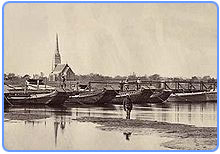 The history of the district dates back to the Hindu mythological period of
the Mahabharata. The epic represents the Salt Range as the refuge of the
five Pandava brethren during the period of their exile, and every salient
point in its scenery is connected with some legend of the national heroes.
Modern research has fixed the site of the conflict between Alexander and
Porus as within Jhelum district, though the exact spot at which the
Macedonian king effected the passage of the Jhelum (or Hydespes) has been
hotly disputed. The history of the district dates back to the Hindu mythological period of
the Mahabharata. The epic represents the Salt Range as the refuge of the
five Pandava brethren during the period of their exile, and every salient
point in its scenery is connected with some legend of the national heroes.
Modern research has fixed the site of the conflict between Alexander and
Porus as within Jhelum district, though the exact spot at which the
Macedonian king effected the passage of the Jhelum (or Hydespes) has been
hotly disputed.
Afterthis event, we have little information with regard to the condition of
the district until the Muslim conquest brought back literature and history
to Upper India. The Janjuas and Jats, who now hold the Salt Range and its
northern plateau respectively, appear to have been the earliest inhabitants.
The Gakhars, who appear to represent an early wave of conquest from the
west, and who still inhabit a large tract in the east of the District; while
the Awans, who now cluster in the western plain, are apparently later
invaders, the Gakhars were the dominant race during the early Muslim era and
they long continued to retain their independence, both in Jhelum itself and
in the neighbouring District of Rawalpindi.
MughalEra
During the flourishing period of the Mughal dynasty, the Gakhar chieftains
were among the most prosperous and loyal vassals of the house of Babar. But
after the collapse of the Delhi empire, Jhelum fell, like its neighbours,
under the sway of the Sikhs.
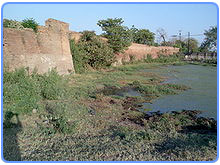 Sikh Era Sikh Era
In 1765 Gujar Singh defeated the last independent Gakhars Chief, Muqarrrab
Khan, and reduced the wild mountaineers of the Salt Range and the Murree
Hills to subjection. His son succeeded to his dominions until 1810, when it
fell to Ranjit Singh. Under the Lahore government the dominant classes of
Jhelum suffered much from fiscal actions; and the Janjua, Gakhars, and Awan
families gradually lost their landed estates, which passed into the hands of
their Jat dependants.
British Era
In 1849. Jhelum passed with the rest of the Sikh territories into the power
of the British. Ranjit Singh, however, had so thoroughly subjected the wild
mountain tribes who inhabited the District that little difficulty was
experienced in reducing it to working order. In 1857 the 14th Native
Infantry stationed at Jhelum town mutinied, and made a vigorous defence
against a force sent from Rawalpindi to disarm them, but decamped on the
night following the action, the main body. being subsequently arrested by
the Kashmir authorities, into whose territory they had escaped.
During British rule Jhelum was a district of Rawalpindi Division, and was
larger than the current district of Jhelum. On April 1, 1990, the tehsil of
Talagang was detached from the District and incorporated with the new
District of Attock.
The old Jhelum district (minus Talagang) covered an area of 2,813 square
miles (7285 km2) and included Chakwal tehsil - it was bounded by Shahpur and
Attock to the west, and by Rawalpindi to the north - the Jhelum River
separated it from Kashmir to the north-east and from Gujrat and Shahpur to
the south-east and south.
Find more about
History of Pakistan
Go To Top
Tribes and Clans
The principal tribes of the district are the Gujjars, Janjua's Awans,
Gakhars, Kashmiri, Khokhars, Pathans, Lilla Qureshis, Phaphra Mughals,
Maliar, Syed and Punjabi Shaikh.
The major clans of the Jats are the Bhukar, Cheema, Dhamial, Ghuman, Gondal,
Hal, Khingar, Khoti, Khatarmal, Mekan, Nagyal, Sipra, Thathaal, and Toor.
The major clans of the Rajput are the Akra, Bharat, Bhakral, Bhatti, Chauhan,
Chib, Janjua Rajput, khokhar Rajputs, Jalap, and Sohlan.
Go To Top
Demography
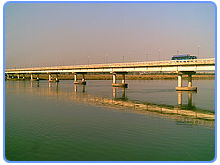 Jhelum is one of the oldest districts of Punjab. It was established on 23
March 1849. Jhelum District has a diverse population of 1,103,000 (2006)
which mainly consists of Punjabis. The population of the Jhelum city
(proper) is about 172,073 (2009) and it is the 35th largest city of Pakistan
with respect to population. Population Density is 261/km. Population Growth
Rate is 1.51 which is very low as compared to other urban areas of Pakistan.
The majority of the population i.e. 98.47 percent is Muslim. Among the
minorities Christians are in majority sharing 1.36 percent in the district.
Punjabi is the dominant language (96.6 percent), while, other languages
spoken in the district are Urdu (1.9 percent), Pushto (1.2 percent). Major
clans are Awans, Akra, Bharat, Gakhars, Gujars, Janjua Rajputs , Jalaps,
Jats (Cheema, Dhamial Jats, Gondal Jats, Ghuman, Sipra, Nagyal jats, thathal
jats), Kashmiris, Khokhars,Lilla Tribe Qureshis, Phaphra Mughals, Rajputs (
Bhakral, Bhatti, Chib, Minhas, Narma, Sohlan, e.t.c), Arain, Syed and
Punjabi Shaikh. Jhelum is one of the oldest districts of Punjab. It was established on 23
March 1849. Jhelum District has a diverse population of 1,103,000 (2006)
which mainly consists of Punjabis. The population of the Jhelum city
(proper) is about 172,073 (2009) and it is the 35th largest city of Pakistan
with respect to population. Population Density is 261/km. Population Growth
Rate is 1.51 which is very low as compared to other urban areas of Pakistan.
The majority of the population i.e. 98.47 percent is Muslim. Among the
minorities Christians are in majority sharing 1.36 percent in the district.
Punjabi is the dominant language (96.6 percent), while, other languages
spoken in the district are Urdu (1.9 percent), Pushto (1.2 percent). Major
clans are Awans, Akra, Bharat, Gakhars, Gujars, Janjua Rajputs , Jalaps,
Jats (Cheema, Dhamial Jats, Gondal Jats, Ghuman, Sipra, Nagyal jats, thathal
jats), Kashmiris, Khokhars,Lilla Tribe Qureshis, Phaphra Mughals, Rajputs (
Bhakral, Bhatti, Chib, Minhas, Narma, Sohlan, e.t.c), Arain, Syed and
Punjabi Shaikh.
Literacy rate of Jhelum is among the highest in Pakistan. The overall
literacy rate for Jhelum is 63.9 percent, somewhat a higher literacy in
Punjab province (46.6 percent). The literacy rate has remarkably increased
from 38.9 percent in 1981. The female literacy rate is 50.5 percent as
against male literacy of 77.7 percent. The rate is much higher in urban area
when compared with rural areas both for males and females. The rural
literacy for both sexes is 58.6 percent (male 74.3 percent and female 44.4
percent), while the urban literacy is 77.2 percent (male 84.9 percent and
female 68.0 percent). 84% of the population have electricity and 96% have
the water facility.
Go To Top
City
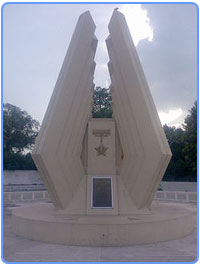 In the past few years, the city has experienced rapid expansion and has
become a vibrant economic and cultural center. The old city has fascinating
narrow streets and crowded bazaars. In the past few years, the city has experienced rapid expansion and has
become a vibrant economic and cultural center. The old city has fascinating
narrow streets and crowded bazaars.
The main market area of the city is centered around "Shandar Chowk", "GTS
Chowk", "Muhammadi Chowk" and includes "Main Bazaar", "Niya Bazaar", "Raja
Bazaar", "Kinari Bazaar", "Sarafa Bazaar", "Chowk-Ehl-e-Hadith" and Soldier
Arcade etc.
Some of the main roads of Jhelum City are Civil Line, Railway Road, Old GT
Road, Kucheri Road, Iqbal Road and Rohtas Road.
A cantonment was built during the British rule, which has grown up into a
strong Garrison, with an Infantry Division commanded by a Major General.
The estimated population of Jhelum in 2009 is 172,073 and the area of Jhelum
is about 22 km2 (8.5 sq mi).
Go To Top
Topography
The district capital, Jhelum City, is situated on the right bank of the
Jhelum River, crossed by a bridge.
The 16th-century Grand Trunk Road passes through the city. Jhelum city is
near the site of the famous
Battle of the Hydaspes between the armies of Alexander the Great and Raja
Porus This battle took place a few miles downstream from the city centre,
along the river banks. Population of the Jhelum city
(proper) is about 172,073 (2009) and it is the 35th largest city of Pakistan
with respect to population. A cantonment was built during the British rule,
which has grown up into a strong Garrison, with an Infantry Division
commanded by a Major General.
Go To Top
River Jhelum
The river Jhelum is navigable throughout the district, which forms the
south-eastern portion of a rugged Himalayan spur, extending between the
Indus and Jhelum to the borders of the Sind Sagar Doab. Its cenery is very
picturesque, although not of so wild a character as the mountain region of
Rawalpindi to the north, and is lighted up in places by smiling patches of
cultivated valley. The backbone of the district is formed by the Salt Range,
a treble line of parallel hills running in three long forks from east to
west throughout its whole breadth.
The range rises in bold precipices, broken by gorges, clothed with brushwood
and traversed by streams which are at first pure, but soon become
impregnated with the saline matter over which they pass. Between the line of
hills lies a picturesque table-land, in which the beautiful little lake of
Kallar Kahar nestles amongst the minor ridges. North of the Salt Range, the
country extends upwards in an elevated plateau, diversified by countless
ravines and fissures, until it loses itself in tangled masses of Rawalpindi
mountains. In this rugged tract cultivation is rare and difficult, the soil
being choked with saline matter. At the foot of the Salt Range,however, a
small strip of level soil lies along the banks of the Jhelum, and is thickly
dotted with prosperous villages.
The drainage of the district is determined by a low central watershed
running north and south at right angles to the Salt Range. The waters of the
western portion find their way into the Sohan, and finally into the Indus;
those of the opposite slope collect themselves into small torrents,and empty
themselves into the Jhelum.
Go To Top
Agriculture
Jhelum District has a total area of 8,58,767 acres, out of which 3,16,815
acres are cultivated. It has four tehsils viz; Jhelum, Pind Dadan Khan, Dina
and Sohawa. The area is located on the eastern part of Potohar upland along
with River Jhelum.
Agriculture in the District Jhelum depends mainly on rainfall. The average
rainfall of the area varies from 20 to 40 inches. About three fourth of this
precipitation is received in monsoon season and the remaining one fourth is
received during the rest of the year. The irrigated area at present is
limited but the emphasis on construction of small Dams and Mini Dams is
gradually increasing. Wheat remains the main crop.
In Tehsil P.D.Khan Salt is the predominant feature which is spoiling the
rich agricultural land day by day. There is a long strip of very rich and
virgin soil along the river which could be made a paradise of citrus
plantation by drip irrigation if the local people are motivated and the
Government of Punjab expressed some interest in it.
Go To Top
Flora and Fauna
Vegetation of the forests of Jhelum Forest Division is dry deciduous scrub
type, Phulai, Kau and sanatha are the main species. The stocking on the
whole is poorand the forests are open. Vegetation is poor on sandstone and
redmarl. The southern slopes are often devoid of vegetation while north
western slopes carry good forests. The forests of Jhelum Forests Divisions
are burdened with right of grazing browsing and firewood. Under settlement
out of total area 93,566 acres only 5,468 acres about (45%) are right free.
Remaining 55% are open to grazing.
The fauna of the District is mostly indigenous restricted, like the
vegetation, but similarly varied and interesting. The rugged and rough
terrain,low rainfall, the scantly cover of vegetation and the burning
passions of the increasing number of hunters, all have their share in
limiting the animal kingdom in the District. The riverine offers a better
environment than elsewhere though the hills support a more interesting
wildlife. Urial and Chinckara are spot aids while wild bores are found in
the Salt Range. Wolves, Foxes and Wild Cats are also found. Hare is fairly
common. Chikor grey and black Partridge are also found in the parts of the
district. Migratory ducks like Teal Pintail and Mallard and some geese visit
during winter.
Find more about
Fauna & Flora in Pakistan
Go To Top
Important Sites
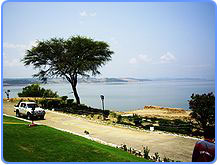 Rohtas Fort is a garrison fort built by the great Afghan king Sher Shah Suri.
This fort is about 4 km in circumference and the first example of the
successful amalgamation of Pukhtun and Hindu architecture in the
sub-continent. Qila Rohtas is situated in a gorge approximately 16 km NW of
Jhelum and 7 km from Dina. Rohtas Fort is a garrison fort built by the great Afghan king Sher Shah Suri.
This fort is about 4 km in circumference and the first example of the
successful amalgamation of Pukhtun and Hindu architecture in the
sub-continent. Qila Rohtas is situated in a gorge approximately 16 km NW of
Jhelum and 7 km from Dina.
The old city has a fascinating labyrinth of narrow streets and crowded
bazaars. Opposite to the CMH Jhelum Cantt is located the beautiful mosque of
the city, CMH Masjid Jhelum.
Located in the cantonment area is the St. John's Church Jhelum which was
built in 1860. There was a local stadium near Gul Afshan Colony which is now
transformed to a Cricket stadium named Zamir Jaffri Cricket Stadium. Close
to Zamir Jaffri Cricket Stadium is located the Altaf Park which was
constructed in 1994-95. Nearly at a distance of 100m from Shandar Chowk, in
the center of city is located Major Akram Shaheed Memorial Park. Major
Muhammad Akram Memorial Library is also present in this park. On the 6th of
September at the occasion of Defence Day, Parade also took place over here.
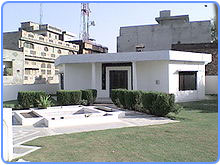 Lehri Nature Park is almost 30 kilometers from Jhelum and 90 kilometres on
GT Road in the hilly Pothohar region from Islamabad. It is 10 kilometres
from GT Road. Lehri Nature Park is almost 30 kilometers from Jhelum and 90 kilometres on
GT Road in the hilly Pothohar region from Islamabad. It is 10 kilometres
from GT Road.
The Mangla Dam is located on the Jhelum River about 30 km (19 mi) from
Jhelum, it is the twelfth largest dam in the world. It was constructed in
1967 across the Jhelum River. There is the Mangla View Resort that is the
first planned resort development in Pakistan to offer residences, villas,
townhouses, hotels, serviced apartments & retail outlets. The resort is
located on a 340-acre (1.4 km2) site on the Mangla Dam area.
Go To Top
Transportation
Within city
Auto Rickshaws are very popular mode of transport for short routes within
the city. Many of the new rickshaws in the city use Compressed natural gas (CNG)
instead of the petrol engines as CNG is environmentally clean and cheaper
compared to petrol. Rickshaws by QingQi are another important mode of
transportation
Out of City
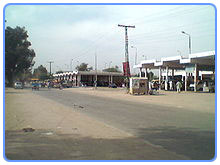 There is a regular bus/Hiace service available running from early hours of
the morning to late night. Daily routes includes Rawalpindi, Islamabad,
Lahore, Gujrat, Gujranwala, Sialkot, Mandi Bahauddin, Sargodha, Chakwal,
Mirpur and Faisalabad. There is a regular bus/Hiace service available running from early hours of
the morning to late night. Daily routes includes Rawalpindi, Islamabad,
Lahore, Gujrat, Gujranwala, Sialkot, Mandi Bahauddin, Sargodha, Chakwal,
Mirpur and Faisalabad.
Regular Bus/Van service is also available with in Jhelum District, It
include some of the important towns and villages such as: Buses from Jhelum
to Pind Dadan Khan, Dina, Sohawa, Lillah, Nakka Khurd, Pind Sawika, Nagyal,
Sanghoi, Mangla Cantt, Nara, Domeli, Darapur, Jalalpur Sharif and many more,
while Vans from Jhelum to sanghoi, Dina, Kharian, Sarai Alamgir, Chak Jamal.
Chak Doulat, Mughalabad, Boken, Dhanyala and many other destinations as well
Railway
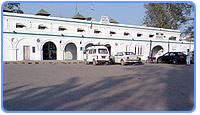 The Jhelum Railway Station was built in 1928 during British rule before the
independence of Pakistan. It was connected by the North-Western Railway to
other cities in the Indian empire. Jhelum is on main line of Pakistan
Railways, and linked to whole country through Railway line across the
Pakistan The Jhelum Railway Station was built in 1928 during British rule before the
independence of Pakistan. It was connected by the North-Western Railway to
other cities in the Indian empire. Jhelum is on main line of Pakistan
Railways, and linked to whole country through Railway line across the
Pakistan
Air
The nearest airport is the Islamabad International Airport, which is
approximately 110 km by road from Jhelum. A small airport called Mangla
Airport, located near Dina, is in use of the aviation wing of the Pakistan
Army.
Go To Top
Sports
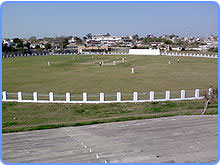 The city also boasts a golf course called the River-View Golf Club, where
national golf tournaments are held regularly. The city also boasts a golf course called the River-View Golf Club, where
national golf tournaments are held regularly.
Also there is a Cricket Stadium named Zamir Jaffri Cricket Stadium where
District lavel tournaments are held regularly. In October 2008, Pakistan
Cricket Board has upraised this stadium for Regional events
There are variety of sports facilities available within the Jhelum
Cantonment which include Cricket fields Hockey Fileds, Football fields,
Tennis Courts, Squash courts and Swimming Pools.
Satellite View of
Sports Centers
Go To Top
Journalism in Jhelum
-
First Newspaper from Jhelum
was published in 1885 by scholer Molvi Faqir Mohammad from maidan-e-Pakistan
under name of SIRAJ UL AKHBAR.He was Baba-e-Sahafat of Jhelum and this
newspaper ceased publication in in 1920.He was author of many books.
-
Weekly NAI ZINDGI started its
publication prior to independence under editor ship of maulana Ghulam Azam
of Gharmala. Later Khadim Hussain Hyderi took editorship till his death in
1960. He was a spokesman of Muslim League.
-
Weekly Khudi started
publication in 1958 and after few years it disappeared.
-
Mohammad Ehsan Butt who was
neighbourer of Sraj ul Akhbar in Chappa khana Mohalla played a vital role in
promotion of journalism in Jhelum.He was affiliated to Zamidar,Kohistan and
Jang Rawalpindi. In 1951 he started fortnightly AMMAL which is being
published till now by his sons Pervez Butt and javed Butt.
-
In 1952 Ishaq Naqashbandi
started weekly NASEEM. This first ABC weekly is being published till now
under editorship of Mohammad Hanif Rai.
-
Voice of Muslim a weekly
started publication in 1970 under editorship of Mahmood Mirza Jhelumi and
later became spokesman of Pakistan Peoples Party.
-
In 1971 Abdul Rahman Muslim
from Jamaat-e-Islami started publication of AWAZ till 1998.After 1998 Mr.A.R.
Saleem started KHAIR UL AMUR which is being published till now.
-
From 1989 to 1994 fortnightly
SAFAT was issued and Mr.Ijaz Choudhary, Sajid Moodi and Pervez Asim were its
editors.
-
Riaz Nizami started GUREZ in
1990 and is being published till now.
-
HARAMAIN a spokeman of
Ahel-e-Hadith started publication since 1990 by maulana Madni & Hafiz Abdul
hameed Ammer.
-
A tri-monthly mag under the
name USHA started in 1996 from Kala Gujran and was closed after a few
issues.
-
Since 1997 Jhelum POST is
being published by Sajid Moodi
-
Weekly ISLAMI NOOR was
published in 1996 by Arshad Minhas.
-
Since 1997 fortnightly PRESS
GALARY is being published by Raja Nobahar.
-
Leopards International a
spokeman of Homeo physicians ceased publication in 1999 after 2 years of his
life.
-
In 1998 AKHBAR-e-Jhelum
started and after departure of its editor Hawe Nizami to USA it ceased
publication. Mr.Nizami also published monthly HAZOOR HAQ for sometimes.
-
Weekly JIRGA started
publication from Dina by Hakim akbar Ali Rana for sometimes and now in
Jhelum it is being Published by Yunus Badnam.
-
Business News a spokeman of
Jhelum chamber of commerce and Industry is being published under editorship
of Qazi Habib ur Rehman.
-
Apnajhelum (Print Edition) is
now published by Shahzad Khan, from Logic Computers Mohammadi Chowk Jhelum
to increase number of Journalism professionals.
The Prominent Journalist worth mentioning from Jhelum are Khaliq Kamran,
Jameel Hashmi, Hakim Mohammad Afghan, Riaz Mirza, Dr.Noor Mohammad Nafir,
Hameed Jhelumi of daily Amroz, Saif ud Din Hussam of Ansari sara(Monthly
GUBAR), Syed Hassan Jaffery, monthly Wasta by Gul Nawaz Ahmed, Crime and Law
by Sheikh Khalid Pervez Akhbar Meherban by Haji Meher ban.
Three colleges are also issuing a yearly magazine while PTC has published a
few books in name of SATHI which Fikar & fun is a magazine of National Hobby
Friends Society
Go To Top
Education
Satellite View of Educational Institutes
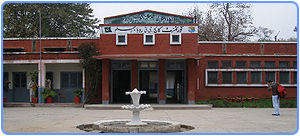 Jhelum has a fairly well-developed educational infrastructure. The overall
literacy rate for Jhelum is 63.9 percent, somewhat a higher literacy in
Punjab province (46.6 percent). Jhelum has a fairly well-developed educational infrastructure. The overall
literacy rate for Jhelum is 63.9 percent, somewhat a higher literacy in
Punjab province (46.6 percent).
Jhelum has 6 Degree Colleges for Women, 6 Degree Colleges for Men, 6
Co-education Colleges, 6 Commerece Colleges, one Law College, with numerous
Higher Secondary Schools and over 150 High Schools.
Higher / Technical Education
In technical education there are two technical colleges, the Government
Institute of Technology, Chak Daulat and the Government Technical Training
Institute. Jhelum also has two sub-campuses of the Virtual University of
Pakistan namely Wings Institute of Learning and Punjab College For
Women.University of the Punjab is also establishing a sub-campus at Jhelum.
Governament of Punjab has allocated 65 kanals of land for this purpose.
Colleges
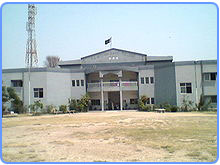 Some of the important colleges of Jhelum are: Some of the important colleges of Jhelum are:
-
Army Public School and
College Jhelum Cantt.
-
FG Intermediat College Jhelum
Cantt.
-
Fauji Foundation Model School
& College, Jhelum Cantt.
-
Bahria Foundation College, GT
Road, Jhelum.
-
Govt. Degree College, Jhelum.
-
Govt. College. G.T. Road,
Jhelum.
-
Govt. College for Women,
Jhelum.
-
Govt. College of Commerce,
Bilal Town, Jhelum.
-
National Foundation School
and College, Jhelum.
-
Govt. Islamia Girls Higher
Secondary School and College, Jhelum.
-
Jinnah Law College Near
Kutcheri, Jhelum.
-
M.A. Jinnah College of
Commerce & Computer Science, Jhelum.
-
PICS, Bilal town Jhelum.
-
City College for Girls,
Jhelum
-
UIML College
Find more about
Worldwide Education Go To
Top
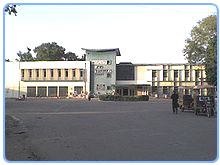 Hospitals Hospitals
Jhelum has some of the largest hospitals in the area which include the
hospital in cantonment area of the city managed by the Pakistan Army or sub
organisations.
-
District Headquarter
Hospital, Jada
-
Combined Military Hospital
Jhelum
-
Fauji Foundation Hospital, GT
Road
-
Khadam Ali Memorial Hospital,
Machine Mohalla No. 1
-
Khan Muhammad Hospital,
AlAsria Road.
-
Sughra Hospital, Jhelum Cantt
-
Shahid memorial trust
hospital Jhelum
-
AlKaram Hospital, Civil Lines
-
Afzal Hospital, Machine
Mohalla No.3
-
Noor-un-Nisa Hospital
-
Fazal Hospital, Civil Lines
-
Azeem Hospital, Jhelum Cantt
-
Umair Children Hospital,
Machine Mohalla No.3
-
Capt.Moazzam Shaheed Hospital
-
Mirza Hospital, Shandar Chowk
Go To
Top
Major Industries
Some of the major Industries are:
Go To
Top
Notable People
People with origins in Jhelum are listed below:
-
Raja Porus who fought against
Alexander in 326BC
-
Major Muhammad Akram, Shaheed
Nishan-e-Haider
-
General Asif Nawaz Janjua,
former Chief of Army Staff Pakistan Army
-
Admiral (R) Tariq Kamal Khan,
former Chief of Naval Staff Pakistan Navy
-
Lt Gen Masood Aslam, SJ, XI
Corps Commander
-
Lt Gen (R) Ejaz Azim, former
Pakistan Ambassador to the United States
-
Lt Gen (R) Afzal Janjua ex
Director General ISI.
-
Air Marshal (R) Raja Shahid
Hamid, former DG Air Weapons Complex
-
Squadron Leader Imran Rafique,
Pakistan Air Force
-
Mian Muhammad Bakhsh, Sufi
saint and a Pahari poet of great repute, he is especially renowned as the
writer of a book of poetry called Saiful Malūk.
-
Raja Ghazanfar Ali Khan
-
Justice Iftikhar Hussain
Chaudhry Chief Justice Of Lahore High Court
-
Chaudhry Altaf Hussain,
former Governor of Punjab
-
Dr. Hasnat Khan, linked to
Diana, Princess of Wales
-
Dr. Anwar Naseem, Adviser
Science, COMSTECH, Islamabad
-
Rabia Qari, First Muslim
woman barrister
-
Syed Zamir Jafri, poet
-
Allama Khalid Masud, a Muslim
scholar of Pakistan, wrote a number of books and articles and delivered
lectures on Islam, science and other subjects.
-
Inder Kumar Gujral, former
Prime minister of India
-
Man Mohan Singh, Present
Prime Minister of India
-
Sunil Dutt, Bollywood actor
-
Satish Gujral
-
Azeem Hafeez, a Pakistani
cricketer, fast bowler
-
Gulzar (lyricist)
-
Aftab Iqbal Shamim, an Urdu
language poet
-
Nosheen Idrees, crowned the
third runner up for the Miss Pakistan World
-
Jaswant Neki, a leading Sikh
Scholar, poet and former Director of PGI, Chandigarh
-
Mirza Dildar Baig
-
Irfan-ul-haq
-
Indra Sen, a devotee of Sri
Aurobindo and The Mother, psychologist, author, and educator, and the
founder of Integral Psychology as an academic discipline
-
Nanak Singh, a poet,
songwriter and novelist in the Punjabi language
-
Jagjit Singh Arora, (February
13, 1916 – May 3, 2005) was the commander of the Indian army in the Eastern
front in the Indo-Pakistani War of 1971 which led to the creation of
Bangladesh. He was born in Jhelum during the British Raj and died in New
Delhi, India.
-
Bhai Mati Das, one of the
greatest martyrs in Sikh history
-
Nasser Azam, successful
contemporary artist practicing in London.
-
Dr Shahbaz Khan international
water scientist and engineer
-
Dr Ghulam Hussain
-
Brig (R) Raja Mansoor, former
Personal Secretary to PM Zafarullah Khan Jamali
-
Maj Gen Saeed-u-Zaman Janjua,
Ex Embassidor Brunai.
-
Maj Gen Agha Mohammad Umer
Farooq, Commandant School of Infantry and Tactics
-
Maj Gen (Dr) Azhar Mahmood
Kiyani, cardiologist.
-
Rear Admiral (R) Mushtaq
Ahmed Brig (Dr) Raja Sami Ullah, Medical Specialist
Go To
Top |




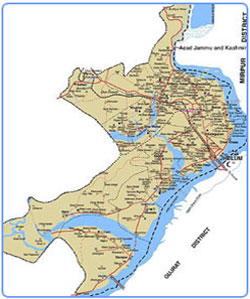
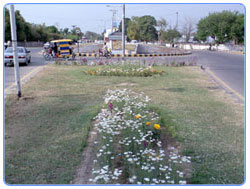
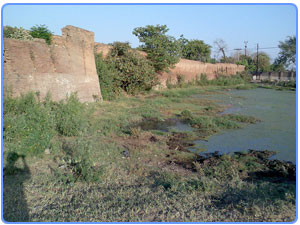
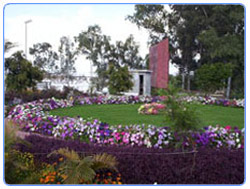
 Jhelum District is in the Punjab province of Pakistan. According the 1998
census the district had a population of 936,957, of which 31.48% were urban.
The district of Jhelum stretches from the river Jhelum almost to the Indus.
Salt is quarried at the Mayo mine in the Salt Range. There are two
coal-mines, the only ones worked in the province, from which the
North-Western railway obtains part of its supply of coal. The chief centre
of the salt trade is Pind Dadan Khan. Jhelum is known for providing a large
number of soldiers to the British and later to the Pakistan armed forces due
to which it is also known as city of soldiers or land of martyrs and
warriors. The district is crossed by the main line of the
Jhelum District is in the Punjab province of Pakistan. According the 1998
census the district had a population of 936,957, of which 31.48% were urban.
The district of Jhelum stretches from the river Jhelum almost to the Indus.
Salt is quarried at the Mayo mine in the Salt Range. There are two
coal-mines, the only ones worked in the province, from which the
North-Western railway obtains part of its supply of coal. The chief centre
of the salt trade is Pind Dadan Khan. Jhelum is known for providing a large
number of soldiers to the British and later to the Pakistan armed forces due
to which it is also known as city of soldiers or land of martyrs and
warriors. The district is crossed by the main line of the  Anjum Sultan Shahbaz recorded some stories of the name Jhelum in his book
Tareekh-e-Jhelum as
Anjum Sultan Shahbaz recorded some stories of the name Jhelum in his book
Tareekh-e-Jhelum as The history of the district dates back to the Hindu mythological period of
the Mahabharata. The epic represents the Salt Range as the refuge of the
five Pandava brethren during the period of their exile, and every salient
point in its scenery is connected with some legend of the national heroes.
Modern research has fixed the site of the conflict between Alexander and
Porus as within Jhelum district, though the exact spot at which the
Macedonian king effected the passage of the Jhelum (or Hydespes) has been
hotly disputed.
The history of the district dates back to the Hindu mythological period of
the Mahabharata. The epic represents the Salt Range as the refuge of the
five Pandava brethren during the period of their exile, and every salient
point in its scenery is connected with some legend of the national heroes.
Modern research has fixed the site of the conflict between Alexander and
Porus as within Jhelum district, though the exact spot at which the
Macedonian king effected the passage of the Jhelum (or Hydespes) has been
hotly disputed.  Sikh Era
Sikh Era Jhelum is one of the oldest districts of Punjab. It was established on 23
March 1849. Jhelum District has a diverse population of 1,103,000 (2006)
which mainly consists of Punjabis. The population of the Jhelum city
(proper) is about 172,073 (2009) and it is the 35th largest city of Pakistan
with respect to population. Population Density is 261/km. Population Growth
Rate is 1.51 which is very low as compared to other urban areas of Pakistan.
The majority of the population i.e. 98.47 percent is Muslim. Among the
minorities Christians are in majority sharing 1.36 percent in the district.
Punjabi is the dominant language (96.6 percent), while, other languages
spoken in the district are Urdu (1.9 percent), Pushto (1.2 percent). Major
clans are Awans, Akra, Bharat, Gakhars, Gujars, Janjua Rajputs , Jalaps,
Jats (Cheema, Dhamial Jats, Gondal Jats, Ghuman, Sipra, Nagyal jats, thathal
jats), Kashmiris, Khokhars,Lilla Tribe Qureshis, Phaphra Mughals, Rajputs (
Bhakral, Bhatti, Chib, Minhas, Narma, Sohlan, e.t.c), Arain, Syed and
Punjabi Shaikh.
Jhelum is one of the oldest districts of Punjab. It was established on 23
March 1849. Jhelum District has a diverse population of 1,103,000 (2006)
which mainly consists of Punjabis. The population of the Jhelum city
(proper) is about 172,073 (2009) and it is the 35th largest city of Pakistan
with respect to population. Population Density is 261/km. Population Growth
Rate is 1.51 which is very low as compared to other urban areas of Pakistan.
The majority of the population i.e. 98.47 percent is Muslim. Among the
minorities Christians are in majority sharing 1.36 percent in the district.
Punjabi is the dominant language (96.6 percent), while, other languages
spoken in the district are Urdu (1.9 percent), Pushto (1.2 percent). Major
clans are Awans, Akra, Bharat, Gakhars, Gujars, Janjua Rajputs , Jalaps,
Jats (Cheema, Dhamial Jats, Gondal Jats, Ghuman, Sipra, Nagyal jats, thathal
jats), Kashmiris, Khokhars,Lilla Tribe Qureshis, Phaphra Mughals, Rajputs (
Bhakral, Bhatti, Chib, Minhas, Narma, Sohlan, e.t.c), Arain, Syed and
Punjabi Shaikh. In the past few years, the city has experienced rapid expansion and has
become a vibrant economic and cultural center. The old city has fascinating
narrow streets and crowded bazaars.
In the past few years, the city has experienced rapid expansion and has
become a vibrant economic and cultural center. The old city has fascinating
narrow streets and crowded bazaars. Rohtas Fort is a garrison fort built by the great Afghan king Sher Shah Suri.
This fort is about 4 km in circumference and the first example of the
successful amalgamation of Pukhtun and Hindu architecture in the
sub-continent. Qila Rohtas is situated in a gorge approximately 16 km NW of
Jhelum and 7 km from Dina.
Rohtas Fort is a garrison fort built by the great Afghan king Sher Shah Suri.
This fort is about 4 km in circumference and the first example of the
successful amalgamation of Pukhtun and Hindu architecture in the
sub-continent. Qila Rohtas is situated in a gorge approximately 16 km NW of
Jhelum and 7 km from Dina. Lehri Nature Park is almost 30 kilometers from Jhelum and 90 kilometres on
GT Road in the hilly Pothohar region from Islamabad. It is 10 kilometres
from GT Road.
Lehri Nature Park is almost 30 kilometers from Jhelum and 90 kilometres on
GT Road in the hilly Pothohar region from Islamabad. It is 10 kilometres
from GT Road. There is a regular bus/Hiace service available running from early hours of
the morning to late night. Daily routes includes Rawalpindi, Islamabad,
Lahore, Gujrat, Gujranwala, Sialkot, Mandi Bahauddin, Sargodha, Chakwal,
Mirpur and Faisalabad.
There is a regular bus/Hiace service available running from early hours of
the morning to late night. Daily routes includes Rawalpindi, Islamabad,
Lahore, Gujrat, Gujranwala, Sialkot, Mandi Bahauddin, Sargodha, Chakwal,
Mirpur and Faisalabad. The Jhelum Railway Station was built in 1928 during British rule before the
independence of Pakistan. It was connected by the North-Western Railway to
other cities in the Indian empire. Jhelum is on main line of Pakistan
Railways, and linked to whole country through Railway line across the
Pakistan
The Jhelum Railway Station was built in 1928 during British rule before the
independence of Pakistan. It was connected by the North-Western Railway to
other cities in the Indian empire. Jhelum is on main line of Pakistan
Railways, and linked to whole country through Railway line across the
Pakistan The city also boasts a golf course called the River-View Golf Club, where
national golf tournaments are held regularly.
The city also boasts a golf course called the River-View Golf Club, where
national golf tournaments are held regularly. Jhelum has a fairly well-developed educational infrastructure. The overall
literacy rate for Jhelum is 63.9 percent, somewhat a higher literacy in
Punjab province (46.6 percent).
Jhelum has a fairly well-developed educational infrastructure. The overall
literacy rate for Jhelum is 63.9 percent, somewhat a higher literacy in
Punjab province (46.6 percent). Some of the important colleges of Jhelum are:
Some of the important colleges of Jhelum are: